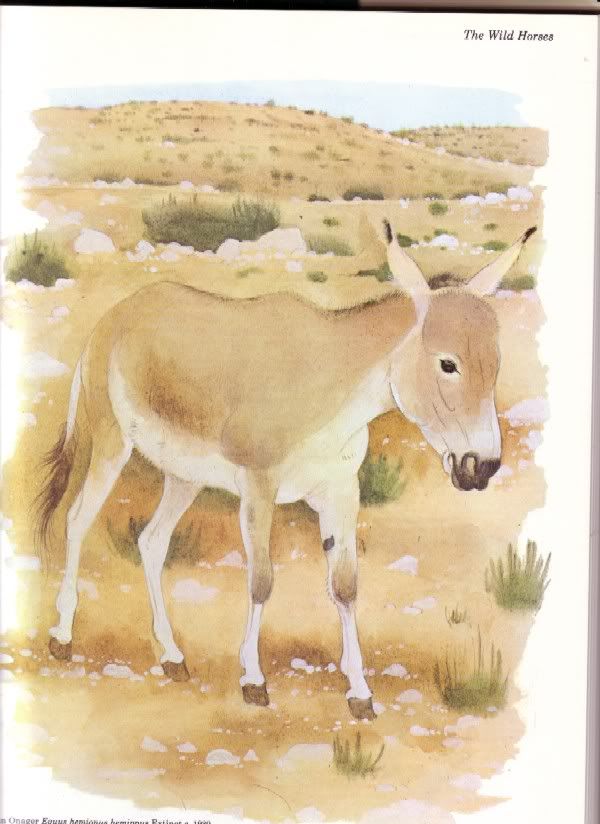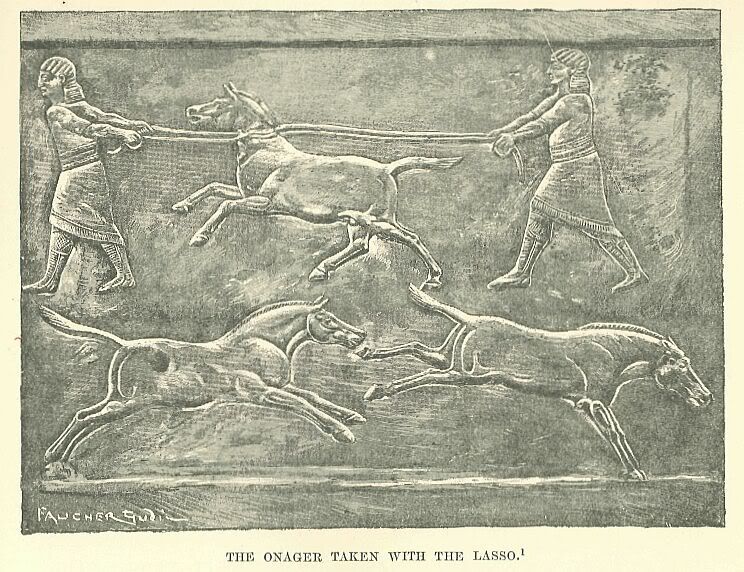|
|
Post by Melly on Mar 4, 2005 18:33:38 GMT
Equus hemionus hemippus formerly occupied the region from Palestine to Iraq (Nowak 1999). The species became extinct when the last known captive animal died in the Vienna Zoo in 1927 (Groves 1974, Clark and Duncan 1992) and the last wild animals disappeared at around the same time (Harrison 1968).
Another subspecies was died out in acient times. Equus hemionus anatoliensis lived near the Euphrates and Karasu up until the end of the 12th century.
Here is a pic:
[ftp]http://planet-mammiferes.org/sespece.php?indice=Equus+onager+hemippus[/ftp]
|
|
|
|
Post by Peter on Mar 4, 2005 19:11:05 GMT
I had never seen a mounted specimen of this animal! Thanks for posting! ;D
|
|
|
|
Post by another specialist on May 9, 2005 15:42:08 GMT
|
|
|
|
Post by another specialist on May 21, 2005 11:36:14 GMT
|
|
|
|
Post by Peter on May 21, 2005 12:22:06 GMT
Direct link:
[ftp]http://www.nhpa.co.uk/bin/nhpa.dll/go?a=disp&t=\us\winpreview.html&rsw=1&si=7E510436CBE54E668E00A1AAA064AA&ir=00017585&hidenav=NaN[/ftp]
|
|
|
|
Post by another specialist on May 21, 2005 13:20:00 GMT
Direct link: [ftp]http://www.nhpa.co.uk/bin/nhpa.dll/go?a=disp&t=\us\winpreview.html&rsw=1&si=7E510436CBE54E668E00A1AAA064AA&ir=00017585&hidenav=NaN[/ftp] Doing it these way you don't get a new window for starters and you need to use the back button to get back to forum. Plus you need to resize the window aswell after using the back button. But atleast the link works |
|
|
|
Post by Peter on May 21, 2005 13:45:14 GMT
True, so for everyone who hates that:  |
|
|
|
Post by another specialist on May 21, 2005 14:11:22 GMT
Great improvement - your a prompt webmaster hard at work all the time and quick at the mark to get things done....
|
|
djg23
Junior Member
 
Posts: 12
|
Post by djg23 on Jun 8, 2005 16:14:07 GMT
There is a photo of a live specimen in John Edwards book 'London Zoo from Old Photographs 1852-1914'....plus many other rarities
|
|
|
|
Post by another specialist on Jun 8, 2005 16:40:58 GMT
|
|
|
|
Post by Melanie on Feb 19, 2006 10:24:18 GMT
Equus hemippus I. Geoffroy St Hilaire 1855: (=Equus hemionus hemippus) Syrian wild ass 1855 Equus hemippus I. Geoffroy St. Hilaire. Syria 1869 Equus hemionus var. syriacus Milne-Edwards. Damascus. The extinct Syrian Wild ass or Achdari was very small in size; the evidence implies that this difference has come about since the end of the Pleistocene (Turnbull 1986). Description: The height at withers is about one metre. The colour is very grading: the sandy-brown flank patch extends well down, grading into off-white on the underside; only the lower 20% or less of the flank is whitish. The dorsal stripe has a clear white border on either side, which becomes obfuscated with age, and eventually disappears. The white wedge between the haunch- and flank-blocs is vague and strongly infused with the body tone. The legs are also strongly infused with body tone. The white zone on the muzzle occupies under 30% of the snout-to-ear distance. On the head, the demarcation between the reddish tone of the face and the white of the interramal region follows the curve of the jaw angle. The dorsal stripe fades out halfway down the tail, and there are no dark rings around the hooves. The nasal bones are raised and are longer than in other onagers (Groves 1986, Fig. 1), whilst the teeth are relatively large. Otherwise, the skull, with its concave profile, highplaced orbit, and high crown, resembles that of a small E. khur. The metapodials are more elongated than in other species, and the terminal phalanges are shorter. Localities: Aleppo. www.iucn.org/themes/SSC/sgs/equid/docs/part3chapter8.pdf |
|
|
|
Post by another specialist on Feb 19, 2006 12:02:30 GMT
|
|
|
|
Post by RSN on Mar 4, 2006 19:12:59 GMT
Picture from Pesquisas de Conhecer - Biologia Geral e Ecologia:  Uploaded in my site. |
|
|
|
Post by RSN on Mar 4, 2006 19:21:56 GMT
Translation for the pic text:
Syrian Wild Ass (Equus hemionus hemippus): lived in Syria and neighbor areas. His very appreciated meat caused it's indiscriminated hunt. Extinct in 1927.
|
|
|
|
Post by another specialist on Mar 5, 2006 9:49:24 GMT
As far as the records show the last wild Syrian onager was shot in 1927 as it came down for water at the Al Ghams oasis not far from Lake Azraq in the Sirhan depression of north Arabia. This lava-bed district seems to have been one of the last three pockets of survival for the wild ass. The other two similar areas were the Jebel al-Druze in southern Syria and the Jebel al-Sinjar on the Iraqi-Syrian border. It was from the Iraqi-Syrian border region that the Schonbruun Zoo received a specimen that was still alive as late as 1928. It may have been the last pure-bred Syrian onager in the world, although some writers continue to express the hope that some onagers may still be hiding out in the desert fastness of Saudi Arabia or Oman, possibly with the Arabian ostrich which was known to keep them company. In 1937 Otto Antonius wrote what may be the true epitaph of the Syrian onager "it could not resist the power of modern guns in the hands of nomads, and its speed, great as it may have been, was not sufficient always to escape from the velocity of the modern motor car". www.arabianwildlife.com/archive/vol1.2/onager.htm |
|
|
|
Post by Melanie on May 1, 2006 13:47:56 GMT
 Doomsday Book |
|
|
|
Post by another specialist on May 1, 2006 20:01:16 GMT
 Drawn by Faucher-Gudin, from the Assyrian bas-relief of Nimrud. See p. 35 of the present work for an illustration of onagers pierced by arrows in the chase. This may show the syrian onager |
|
|
|
Post by another specialist on May 1, 2006 20:05:13 GMT
|
|
peej
Junior Member
 
Posts: 21
|
Post by peej on Mar 28, 2007 1:59:58 GMT
Does anyone happen to have the photograph from the book 'London Zoo from Old Photographs 1852-1914'?? Or know somewhere on the web where I can find it?
|
|
|
|
Post by another specialist on Mar 28, 2007 8:40:53 GMT
personally i've been trying to find it on the net since it was mentioned but with no luck at moment
|
|